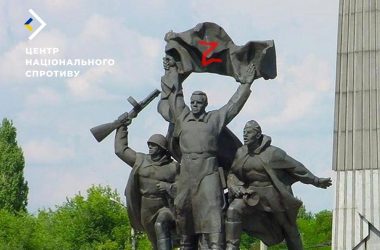Occupiers manipulate historical facts to justify their right to seize land. We explain how it works.
Russia has been rewriting the history of its occupied territories for centuries. As soon as Russian troops are entrenched in certain lands, the clearing of the local cultural field immediately begins there. The fact that Russia is now destroying Ukrainian books, looting museums, and conducting tours of the TOT is not something new – the empire has worked out these mechanisms for centuries.
In Russian historiography, it is already common practice to describe the history of various regions with the narrative that civilization appeared on them only from the moment they “joined” the Moscow Empire. This is according to the plan of the propagandists and justifies the Russian Federation’s right to aggressive wars.
For Ukraine, the example of the Crimean peninsula, which the Kremlin refers to as “primarily Russian land”, is very telling. After the final defeat of the Crimean Khanate during the Russian-Turkish war and the consolidation of the occupation of the peninsula in 1774, 500 buildings were “razed to the ground”, many of them in Kerch.
These buildings were examples of Mediterranean architecture, the heritage of various cultural eras from Greco-Roman antiquity to the medieval heyday of the Crimean state. Even now, Russia is destroying the remains of Chersonesus and the khan’s palace in Bakhchisarai.
If it weren’t for this horde of cities from Kerch to Simferopol, they would look like Bulgarian Nessebar, Sozopol or Turkish Trabzon. Now these are “canonical Russian lands”, where there are almost no monuments that would prove otherwise.
As soon as Catherine II eliminated the Zaporizhia Sich, and with it all the remnants of the Hetman’s autonomy, Moscow chroniclers eagerly began to rewrite the history of Ukrainian lands. So, one by one, myths began to appear about the “founding empress”, who built a bridge in the “Wild Field”.
According to one of them, she allegedly built Luhansk from scratch in 1795, although 100 years before that there were Ukrainian Cossack settlements of Kamiany Brid and Vergunka. Namely, how the city of Luhansk was formed in 1882. Not only that, it was Catherine II who turned local Cossacks and peasants who had never known slavery into serfs-slaves.
Slovyanoserbsk? (Luhansk region) An old Cossack winter camp of the Kalmius palanka of Zaporizhzhya Sich, which was called Pidgorne tract. Known at least since 1740. The surrounding lands were handed over by Empress Elizabeth to Serbian mercenaries, who knew how to keep records of “dead souls” no worse than the modern PMC “Wagner”, for which already under Catherine II, Slovyanoserbsk was integrated into the then “New Russia”. Which is not surprising, because Russia values mercenaries and collaborators exactly as long as they are beneficial to it.
Zymohirya (Luhansk Region) winter camp of the Kalmius Palanka of Zaporizhzhya Sich (fortress) under the name Cherkassky Brid (1645).
For the Donetsk region, Soviet historiographers nurtured the myth of Donbas – an industrial crucible to which “Russian tsars brought civilization.” The core of local industry was created by investors from Europe and Ukrainian tycoons, and labor resources were recruited from the settlements already present there.
Mariupol? In 1779, the same Ekaterina “gave the emigrants from Crimea privileges and freedom.” If we translate from the imperial novoyaz, this is a special settlement created for the Greeks of Rumei and Urum who were deported from the peninsula, and also on the lands of the old Kalmius fortress of the Zaporozhian Cossacks Domakh, founded in 1594.
Donetsk? Long before John Hughes, there was a Zaporizhian settlement of Oleksandrivka founded in 1779 by Yevdokym Shidlovsky, a descendant of the Izyum colonel, and settled by natives of the Dnipro region.
Bakhmut? Zaporizhzhya salt works, founded by the Cossacks of the Izyum Slobid regiment around 1680-1690s, and according to other data, in 1701.
Toretsk? (Donetsk region) began with the Shcherbynivka settlement, which was founded by the Boguslav Cossack Anton Shcherbyna in the 17th century.
Kharkiv Region, Slobid Ukraine – here Russia rooted the myth of the hussar regiments of the Napoleonic Wars, as well as the “first capital”, but what?
Kharkiv? The settlement was built in 1654 by the Donets-Zakharzhevsky Cossack family on the site of the ancient Russian city of Donets, which is mentioned in the Ipatiev Chronicle as far back as 1185.
Izyum? It was built in 1681 by the Kharkiv colonel Hryhoriy Donts-Zakharzhevsky opposite the earlier “town” of the colonel of the Balakliya Slobid Cossack regiment Yakov Chernihivets. Later – the center of the Izyum Cossack Regiment.
What about the South?
Odesa? The myth about Katerina and Potemkin is still popular, bypassing the fact that before the Russians there were a number of settlements on the territory of the ancient Odessa. In particular, the ancient Ukrainian fortress of Kotsyubiiv, founded by the noble magnate Kotsyuba-Yakushinsky in 1415. It was then that the famous Peresyp was formed. It was during the period of the Grand Duchy of Lithuania, Russia and Zhemaitia during the reign of Prince Vytautas.
Kherson? Built on the basis of a Cossack settlement of the 17th century. – the town of Bilikhovichi, which is at least a hundred years older than the Potemkin fortress.
Berdyansk? The port town was founded in 1673 by Zaporizhzhyaand Azov Cossacks.
Mykolaiv? In 1399, in the southern part of the modern city of Vytovtsi, the Grand Duke of Lithuania Vytautas built the Vytovt Castle (fortress) and a customs office to control trade with the Crimean Tatars, not on a bare spot, but on the site of the settlement of Rus’ times – Vynogradna Krynytsia. And long before Potemkin and his shipyard, the territories adjacent to it were developed by the Russians, who moored their trading boats and ships here on their way to Byzantium, and the Zaporizhzhya Cossacks settled in these surroundings from the 15th century, and from the 18th century. served the crossing across the mouth of the Ingul River.
So, we can see that long before the arrival of Moscow, these areas of the south of the forest-steppe zone and the great steppe were developed and cities were built on the site of the ancient cities of Rus or the Lithuanian-Russian principality.
Ukrainians inhabited the north of the Crimean peninsula, where they lived next to the Crimean people, contrary to Russian propaganda about the evil and treacherous Crimean Tatars. Even without the participation of the Russians, the local people managed to develop agriculture and horticulture in these areas and developed this region industrially.
Therefore, on our land, we protect the heritage of our glorious ancestors, while Russian propaganda feeds its population with imperialist myths, rejecting everything that existed before its seizure of these lands.




